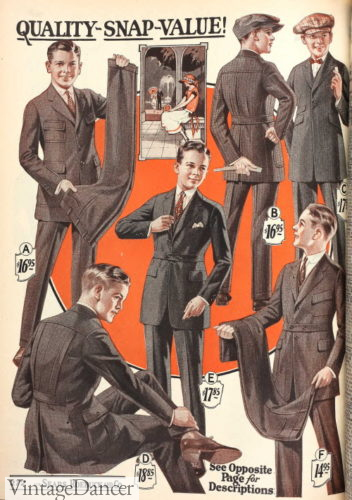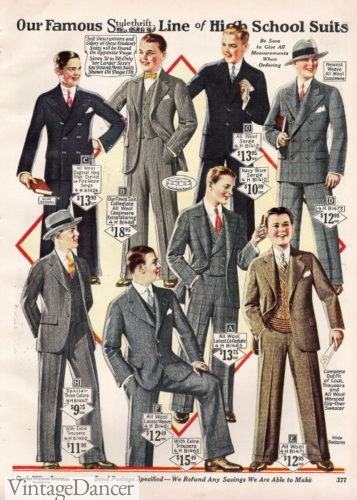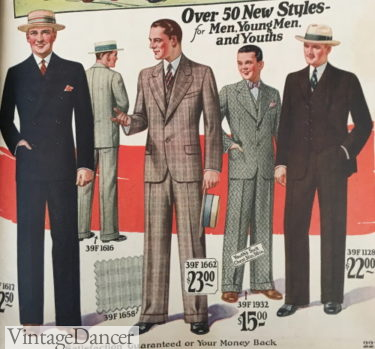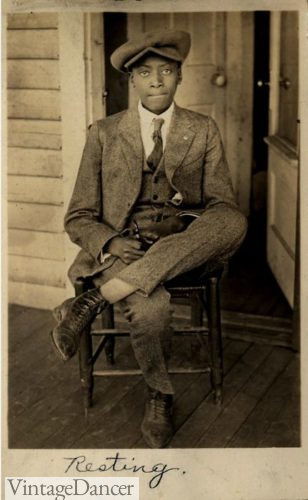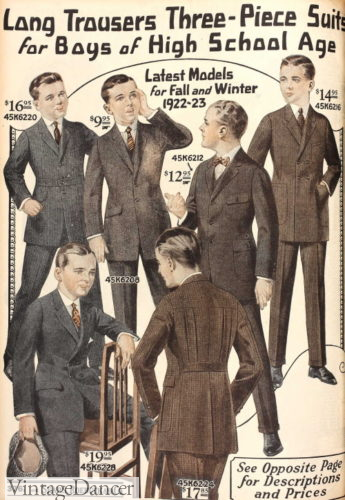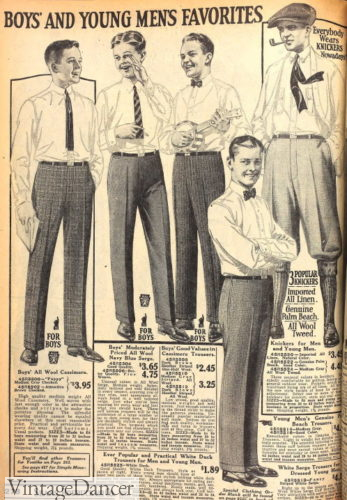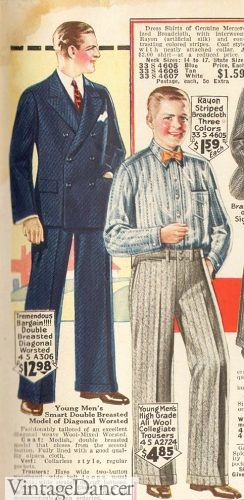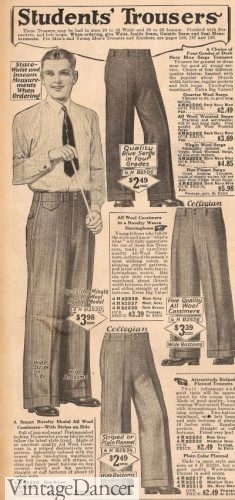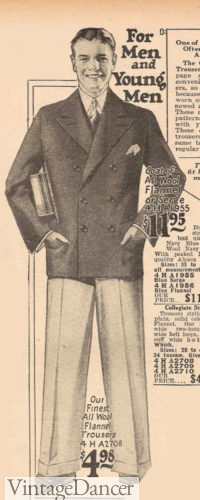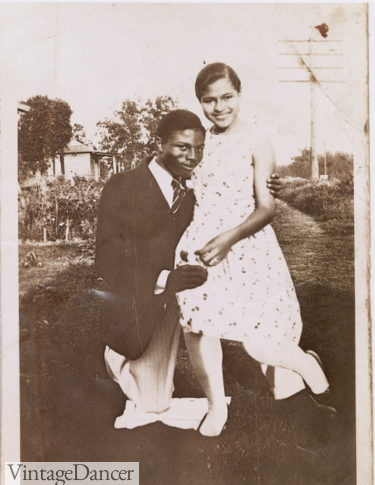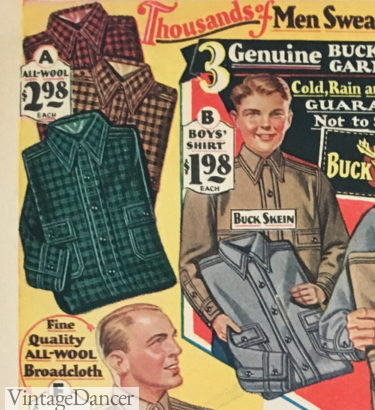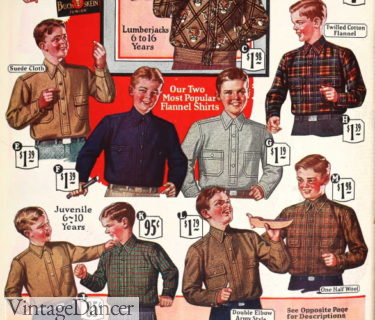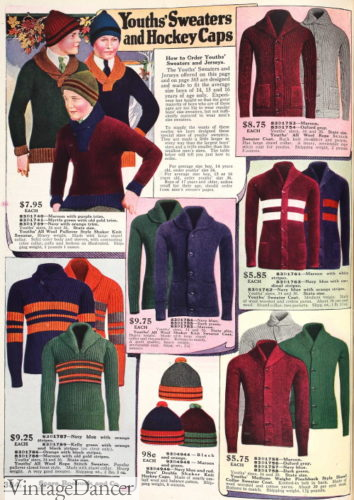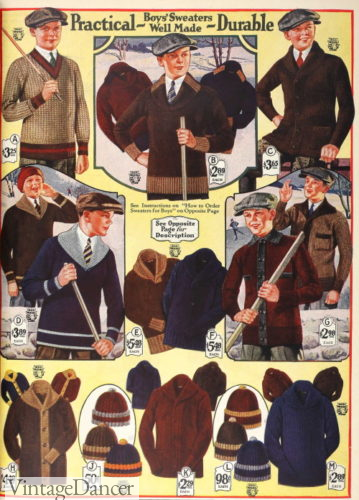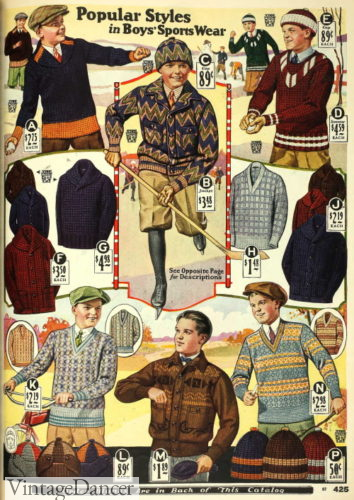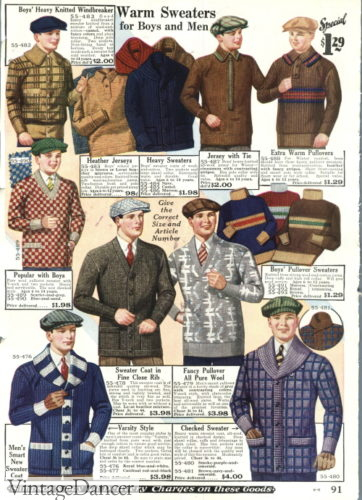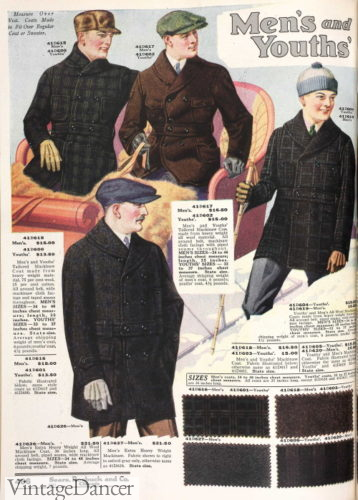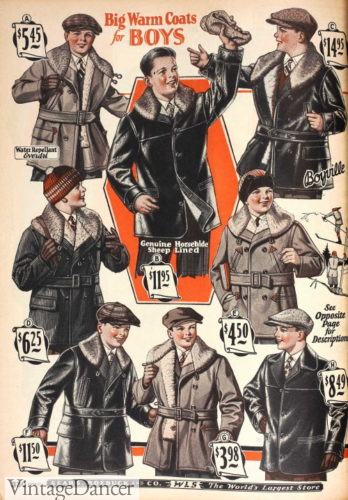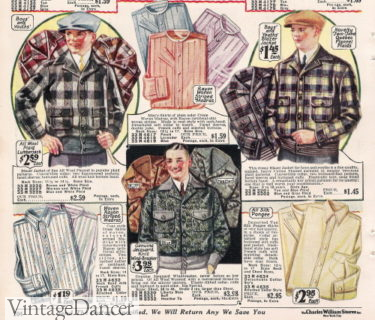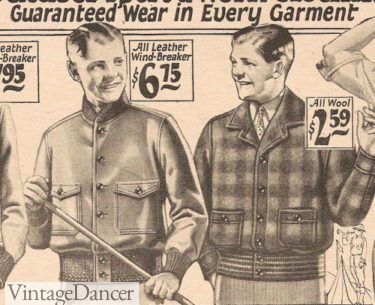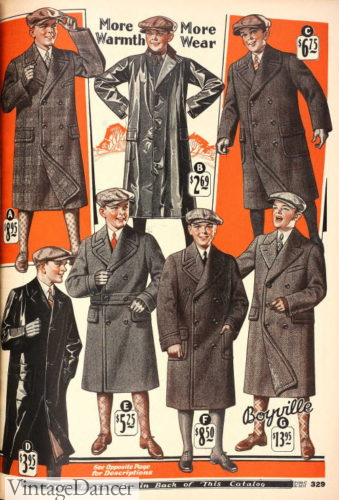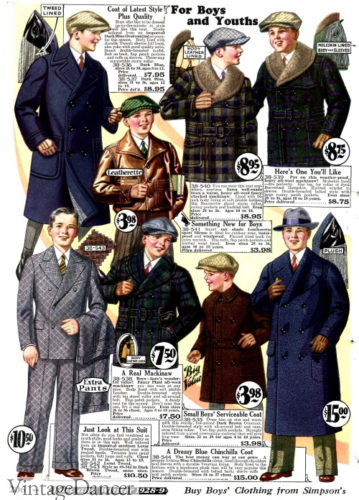How did young men, older boys, and teenagers dress in the 1920s? Teenage boys clothing in the 1920s did not differ drastically from that of grown men. Suits were worn daily while weekends had them in separates and workwear mixed with casual knitwear.
1920s Teenage Boys Suits
For special occasions, church, and urban high schools, a suit and tie was worn daily. They looked like a smaller version of their father’s suits with a few minor differences.
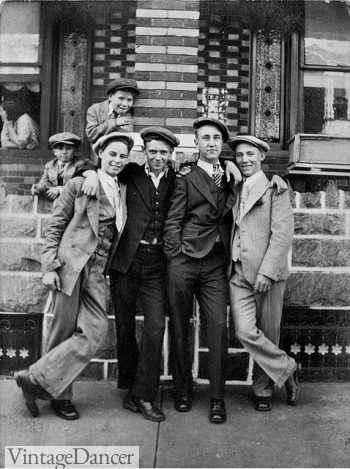
Philadelphia 1925, teen boys in young men’s suits with flat caps
For one, color. The younger generation wanted more color and appealing patterns in their clothing. Vertical stripes, diagonal stripes, checks, Glenn plaid, and solids came in lighter shades of blues, grays and tans than men’s versions.
The tailoring of the suits was softer too. Hard square edges on jackets and lapels were replaced by rounded lapels, sloping shoulders, and extra loose fitting trousers. The general trend of the ’20s was “everything soft.” Soft collars, soft tailoring, soft colors, and soft materials.
- 1924 teen suits with belts/half belt backs
- 1927 teen suits
- 1927 men and teen suits
- A well dressed teen in his suit and flat cap
Suits were almost always wool, even in summer, but wool flannel and wool cassimere were softer and easier to move in, making them ideal for active teens. With the exception of business suits for young men that worked, they also preferred the single breasted suit over the double breasted. Same with vests — single breasted matching suit vests were more common than double breasted.
Besides colors and materials, the other change in suits throughout the 1920s were the pants. In the very early ’20s, the skinny “Jazz Suit” was still popular with teens. As the decade progressed, pants grew wide and loose with large cuffs or turn ups at the ankle.
- 1922 teen suits with long trousers
- 1924 teen dress pants and knickers
As you can see in the picture below, by 1927 the pants were very wide legged, whereas the earlier pictures show legs that were about the same width as most classic suit pants are today.
- 1926 (L) teen boys blue suit and (R) dress slacks with stripe shirt
- 1927 Teen boys wide pants and dress shirt
Dress shirts were almost always white with soft round “club” collars or the new pointed shirt collar. For casual wear, a colorful shirt would have been preferred, made of stripes in an array of blues, greens, and pastels for summer. A colorful tie would have been worn. Red, blue, gold stripes, paisley, or small prints were the most traditional for the ’20s for both men and teens. Teens probably preferred the bolder colors.
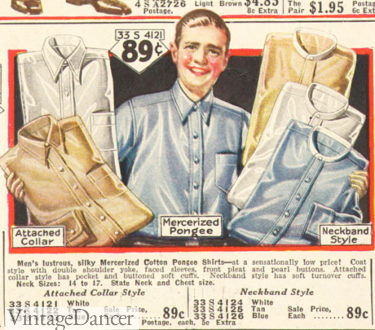
1926 teen boy dress shirts
I like to read the captions from catalogs to get a good feel for the clothing:
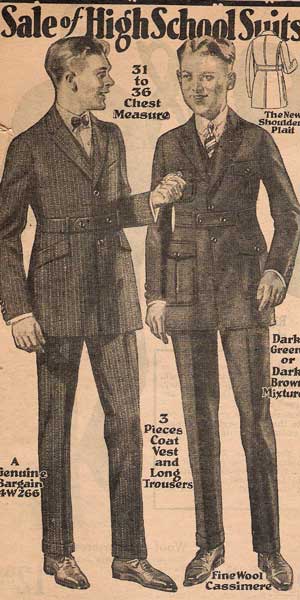
1923 Teen Suits with Belt
1923 – Pencil Cut Cassimere Suit (above): We are confident that this good-looking belted model of good quality Wool Mixed Cassimere, in pencil striped Brown or Dark Green, will more than please the High School Youth who wants distinctive style. Two button, single-breasted style with all all-around belt, slanted flap pockets, upper welt breast pocket and inside pocket. Good lining. The vest is collarless, finished with the usual pockets and details. Trousers have two side, two hip and watch pockets; belt loops; suspender buttons. Straight or cuff buttons.
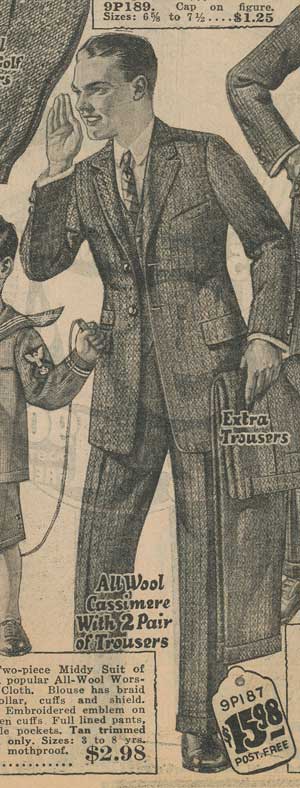
1924 Cassimere Suit
1924 – (above): Stylish, well-tailored Suit of fancy mixed All-Wool Cassimere in the latest shades of brown and gray. Semi-form fitting coat in single-breasted style and fully lined with tropic weight All Wool Alpaca. High cut vest. Two pairs of long trousers with your choice of plain or cuff bottoms.
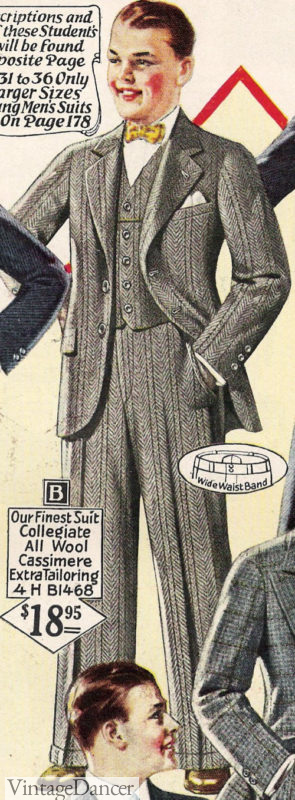
1927 cassimere grey suit
1927 -(above)-Designed for young men who desire “something different.” Exceptionally well tailored in the newest weave All Wool Worsted. The distinctly attractive Summer shades are made strikingly snappy by the harmonizing stripes. Coat: The latest one button model, with slanting slashed pockets, upper welt and inside breast pockets, rounded front and stylishly shaped lapels. The coat is half lined with durable alpaca. Trousers- Have the last minute, wide, two-button waistband and wide belt loops Straight or cuff wide bottom. Sandy brown or blue-grey fabric choices.
1920s Knicker Suits
A right of passage from boy to men was to wear long pants instead of knickers. Knickerbocker suits were what young boys wore but also what teen and men work for sporty occasions. Many teen boys continued to wear knicker suits into high school or after school activities.
Boys who played golf also wore knickers, now renamed plus fours, with tall pattern socks, sweaters and caps. More about long pants and knickers.
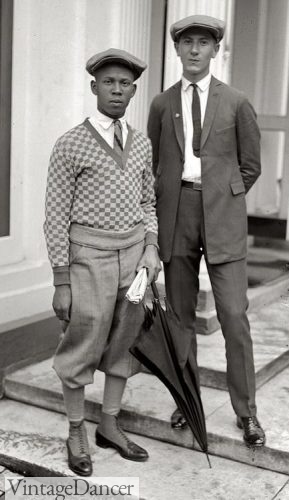
Thomas W. Miles and Simon Zebrock of Los Angeles – 1924 teenage boys in (L) knicker pants with sweater and (R) skinny “Jazz” suit. Both wearing flats caps or “newsboy” caps
What would he have worn to his high school graduation or other special event? His best suits or summer set of white flannel pants and blue blazer. I call these the Captain of the yacht look. Some formal dances called full a full tuxedo.
- 1927 blue blazer with white flannel trousers
- 1920 Sampson Smith with Rosa McCauley Parks
1920s Casual Teen Boys’ Fashions
While most teens boys wore suits every day, there were times they would dress more casually on weekends, for sports, or while working a job. Many poor or working class families needed boys to enter the workforce by 12 or 13 instead of finishing school. They worked as shoeshines, newsboys, factory workers, delivery boys, etc. They dresses in workwear clothes such as overalls, chambrey shirts, wool pants and chore coats. Learn more here.
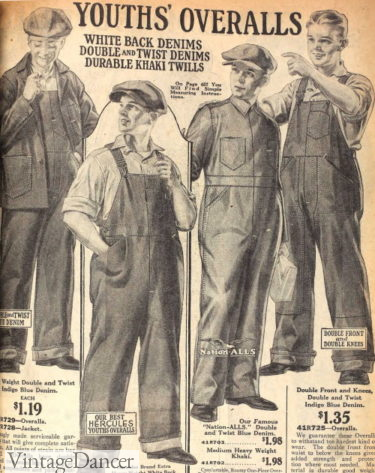
1924 overalls, coveralls workwear for teens
Lower class boys still wore suits on weekends, but they were almost always hand-me-downs or second-hand purchases. The coats and jackets usually did not match, or fit very well. Ties were not often included or detachable shirt collars. The look was dressy by today’s standard but a miss-mash back then. This rustic workwear look is back in style now.
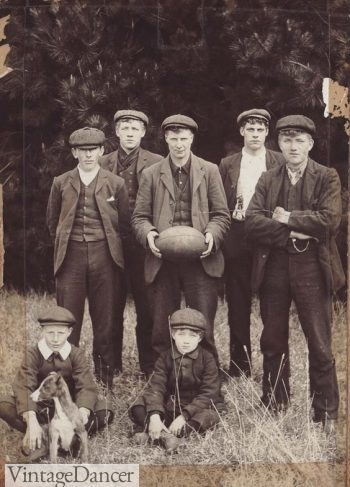
Young teenagers in working class or weekend clothing playing football
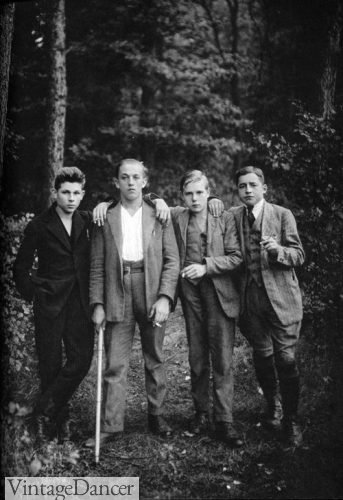
1927 teenage boys casual fashion. Casual still looks dressy to us today, but these boys were probably up to no good.
1920s Boys Shirts and Sweaters
Beside dress shirts for school boys would wear casual or sport shirts during the off hours. These wool or cotton flannel shirts had two flap pockets and came in many dark colors and small patterns. They were always long sleeved but teen boys would roll up sleeves to elbow in the summer.
- 1929 teen boy shirts
- 1928 boys and teen shirts
Knitwear was where all the color was at in the 1920s. While suits and trousers were neutral drab colors sweaters were bright, bold, colors and wide stripe patterns. They came in pullovers with busy patterns such as fair isle and checks or solid colors with contrasting collars and cuffs. The chunky shawl collar cardigan was a new favorite as the roll neck jersey sweater remained a classic. More about 1920s sweaters.
- 1920 sweaters and hats
- 1925 sweaters and cardigans
- 1927 boys knitwear
- 1928 sweaters, cardigans, knit jackets
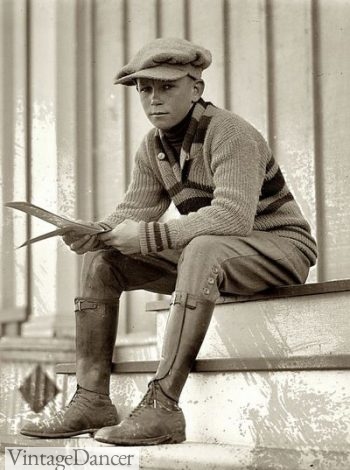
A 1920s real “newsboy” dressed in cap, shawl collar sweater, knicker pants, leather gaiters and Oxford shoes.
Boys would choose a warm knit sweater over a suit jacket most days. The hybrid knit jacket called a Lumberjack blouse was a compromise. Made of a knitted fabric it buttoned up the front and had cuffs and collars like most jackets. You won’t find these in fashion today which is a shame.
Other styles of casual jackets were the plaid wool Mackinaw coat, often lined in shearling. The wool or leather surcoat with shearling or fur collar was very warm and stylish. And the windbreaker jacket made of wool fabric was cut in the same shape as the lumberjack. More about 1920s coats and jackets.
- 1920 Mackinaw wool coats
- 1928 surcoats in wool or leather
- 1927 wool plaid jackets
- leather or wool jackets
For heavy winters outerwear (there was no indoor heating yet) a teen needed a long wool overcoat or waterproof raincoat. In the early 1920s large plaid was a popular pattern while the later 1920s bought up the new bright blue overcoat.
- 1928 wool overcoats and raincoats
- 1928 teens boys coats, jackets and suit
1920s Teen Shoes
Young men’s shoes were standard brown lace up Oxfords or lace-up dress boots. They had cap toes and often brogue detail on the seams. Toes were round and blunt, gradually coming to a rounded square toe by the late ’20s. Soles were rather thick rubber even in dressier styles.
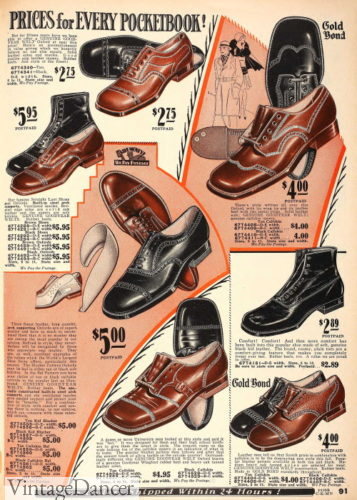
1929 boy and teen shoes and boots
Both shoes and boots were popular in the early 1920s, but by the end of the decade, boots were only worn by boys and working-class men. The iconic two-tone lace-up shoes could have been worn by teens in suits, but they usually wore them for casual everyday activities and sports.
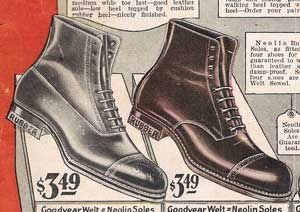
1924 Teen Men’s Boots with Cap Toe and Brogue
For active sports such as basketball, tennis, football and gym class boys work the latest sport sneakers. They looked like Converse shoes. More about gym clothes.
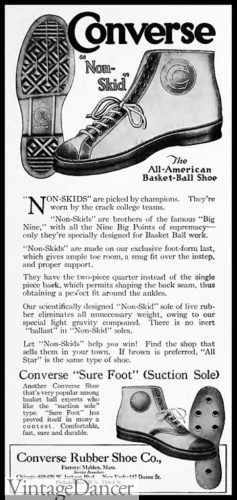
1920s Converse sport sneakers
1920s Teen Hats
The final touch was the hat. Wearing a man’s hat was a rite of passage for teens. As boys and teens, they wore 8-panel caps, often called flat caps or newsboy caps today. For very formal occasions, they might have worn a fur felt hat in similar shapes as the man’s homburg or Fedora.

1927 teen boy caps
In general, teens and young men were hatless. It wasn’t customary to wear a hat until you were at least college age or in a career that required wearing suits daily. High school boys may have worn a hat at graduation if it was held outdoors. Otherwise, with an indoor event they would be hatless.
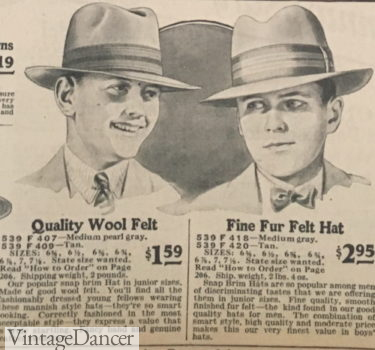
1927 snap brim fedora hats for teens
More Teenagers Fashion History
1940s Teenage Fashion for Boys
Debbie Sessions has been teaching fashion history and helping people dress for vintage themed events since 2009. She has turned a hobby into VintageDancer.com with hundreds of well researched articles and hand picked links to vintage inspired clothing online. She aims to make dressing accurately (or not) an affordable option for all. Oh, and she dances too.
